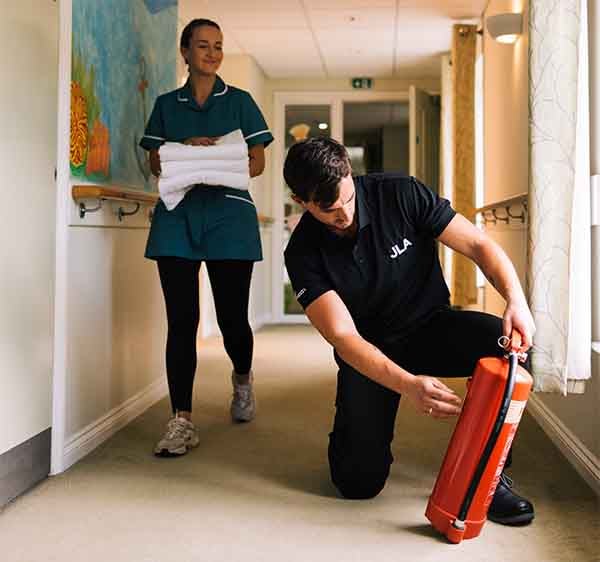Whether you’re running a small local care home or a nationwide group, the safety of your residents, staff and visitors will be paramount. Legal compliance is part of the picture, with regulation like the Regulatory Reform (Fire Safety) Order 2005 needing to inform your fire safety strategy.
In this guide, we outline the key fire safety essentials for your care home, including the most important things to consider, the main causes of care home fires, and the active and passive fire safety measures you can put in place to protect people and property.

Challenges to consider
Vulnerable residents
Care home residents often include elderly people, those with physical disabilities, cognitive impairments such as dementia, and sensory challenges like hearing or vision loss. A large challenge, then, is making sure that every resident can be safely evacuated in the event of a fire. Evacuation times for these residents could be significantly longer, especially if they require an aide to walk, which needs to be factored into your risk planning.
Staff training
The care sector often struggles with high employee turnover, with many homes relying on agency personnel to meet shortfalls. This makes it harder to ensure all staff and contractors are trained and aware of your home’s fire safety protocols.
Other people on-site
From loved ones to service engineers, volunteers to entertainers, healthcare workers to delivery people, your care home is likely to have people on site who have little to no awareness of your fire safety measures, or what to do in an emergency.
Older premises
Another major challenge to care home fire safety is the design and age of your building. Many care homes operate in older properties which are unlikely to have been built with modern fire safety standards in mind.
Complications might include outdated wiring, limited compartmentation options, or narrow corridors that complicate evacuation.
Retrofitting buildings like these with fire-resistant materials, sprinkler systems and compliant fire doors can be costly and logistically tricky, especially if residents are living on-site.
Key causes of care home fires
According to the London Fire Brigade, 41% of home fires are caused by cooking; 21% are caused by kitchen appliances, and 13% are smoking-related.
This means particularly focus and attention should be paid to staff training on kitchen safety, while also making sure all appliances are safe, well maintained, and regularly tested. Residents and staff should also be reminded about the hazards of smoking.
Active and passive safety measures
The following fire safety measures should be in place in order to maintain everyone’s safety – as well as your ongoing compliance all relevant fire regulations.
Fire risk assessments and planning
A fire risk assessment is a detailed, step-by-step process, conducted by a responsible person (or BAFE-accredited third-party contractor) to review your building and on-site activities, and identify potential fire hazards. The assessment can then be used to create a fire safety action plan.
Fire detection and alarms
A modern fire alarm system, regularly tested and maintained, will make sure your care home staff and residents can respond quickly should a fire break out, giving you time to evacuate safely.
Fire extinguishers
Appropriate fire extinguishers should be available throughout your home, allowing you to respond to different fire risks in different locations. Staff must also be trained on how to use them safely.
Emergency lighting and signs
If there’s a power failure or build up of smoke, an emergency lighting system, which should illuminated exit signs, will help to mark out escape routes and guide people to safety.
Automatic opening vent (AOV) systems
By clearing smoke and hazardous gases from corridors and other communal areas, AOVs help to keep escape routes clearer for longer, and give emergency services faster access to trapped residents or fire locations.
Fire doors
In an emergency, fire doors act as your first line of defence, slowing the spread of fire and smoke through your home. This is why it’s so important that every door is correctly fitted and regularly inspected. JLA’s own fire-resistant doors are manufactured to BM Trada Q Mark FD30 and FD60 standards.
Compartmentation
By dividing up your care home into fire-resistant sections, you’ll be able to contain fire to one area, giving your residents and staff more time to evacuate while limiting damage to your property.
More help and guidance
The UK Government has published specialist fire safety guidance for care homes, which was last updated in September 2023. This includes handy information on fire risk assessments, fire detection, and prevention measures.
For more help with fire safety and compliance, don’t hesitate to get in touch with our own experts – simply contact us today.



